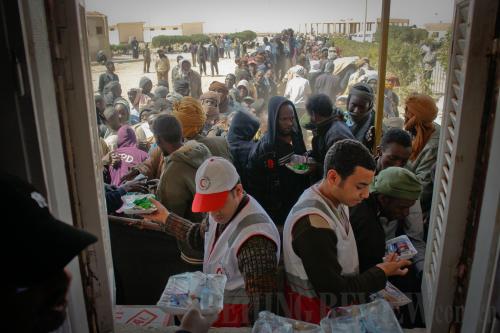|
 |
|
CAMP LIFE: Refugees stranded by bloody clashes in Libya line up to get food and water from the Egyptian Red Crescent on the Libyan-Egyptian border on March 29 (CAI YANG) |

The massive upheavals sweeping the Arab world started on January 14 this year when Tunisian President Zine El Abidine Ben Ali fled abroad after protesters demanded he step down as the country's leader. Egyptian President Hosni Mubarak followed in a similar fashion, resigning in the face of protests on February 11.
Libya, too, became a hotspot of social unrest in March as protests escalated into a civil war that eventually became an international conflict. France, the United States and the UK have since joined the fray in support of Libyan rebels trying to oust Libyan leader Muammar Gaddafi, a ruler of that country for more than 40 years.
This growing turmoil has severely impacted these countries' economies and the lives of their people. Now, the ripple effect is expanding, sending shock waves through international commodity and financial markets.
Behind the protests
Economically speaking, the per-capita income of each country that has experienced or is experiencing social unrest and their economic situations in general are not that bad, compared with other countries in the Middle East.
The UN's Statistical Yearbook lists Libya's 2008 per-capita GDP at $14,479, Tunisia's at $3,955, Egypt's at $2,162, Algeria's at $4,588, and Bahrain's at $27,248. Tunisia, the first nation to undergo a shift in government leadership, has enjoyed a 5-percent average annual GDP growth rate in the past 20 years—a feat that has attracted a flood of attention from across the world.
The ultimate cause for civil unrest across the Middle East was a high unemployment rate that left many young people without jobs. Those young people became fed up with all-talk-no-action politicians who did nothing to improve people's lives—so they demanded change. The prevalence of corruption and social injustice added to people's dissatisfaction.
In fact, the high unemployment rate among young people was largely due to Arab countries' rapid population growth and defective economic structure. Also, while natural resource industries—oil and natural gas—prospered, other industries remained underdeveloped and unable to provide a solid base for job growth.
Oil woes
Why cannot the oil industry coexist with manufacturing industries?
First of all, the oil revenues of the countries in question negatively impacted their manufacturing industries. As revenues from oil exports increased, a large quantity of petrodollars poured in, strengthening the countries' currencies. As a result, even though the prices of their manufactured goods did not increase domestically, they went up in the international market, while the prices of imported products dropped. This undermined the competitiveness of oil-exporting countries' products, causing consumers to buy goods from other countries instead of domestically produced ones.
In addition, an industry's development cannot go without labor, capital, land and other factors of production. The oil industry definitely has the upper hand in this respect. Able to provide higher salaries, the oil industry absorbed a disproportionately large number of skilled workers in oil-rich Arab countries, leaving other industries with the leftovers of the labor pool. Higher profit margins also allowed oil companies to obtain a larger amount of investment. In this way, the oil industry realized expansion at the expense of other industries.
This labor drain has been common throughout history. The UK, Norway, the Netherlands and other countries in northern Europe experienced this trend when drilling for oil in the North Sea in the 1970s. Also, Russia has a massive revenue stream from oil exports, but has had to witness the decline of its light industries and traditional heavy industries.
For years, oil-exporting countries in the Middle East have vigorously promoted economic diversification. But few countries have seen noticeable results. Many countries' non-oil industries lacked international competitiveness in product prices and quality. Amid trade liberalization, these industries were forced to depend on government subsidies to survive. Some high-income countries also spent a large amount of money developing industries clearly incompatible with local natural conditions, such as planting wheat in the arid region.
| 